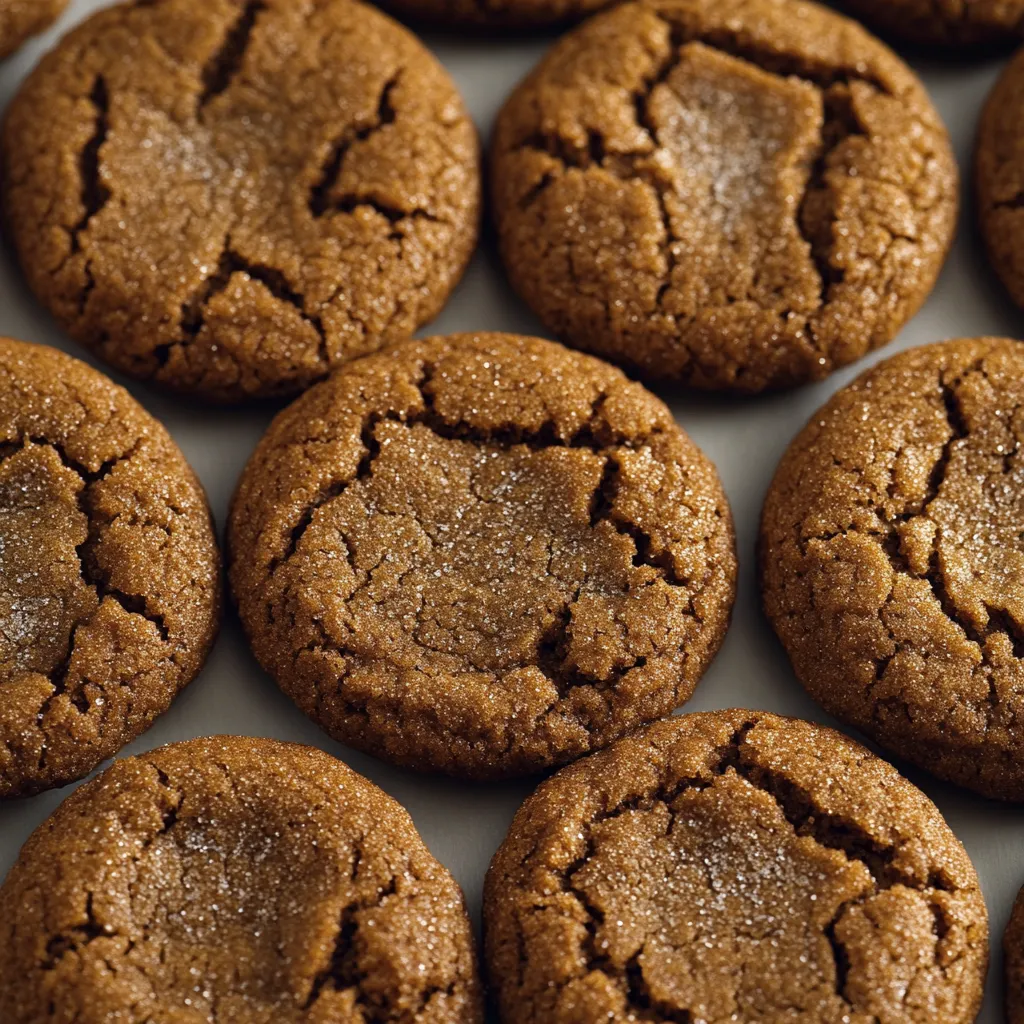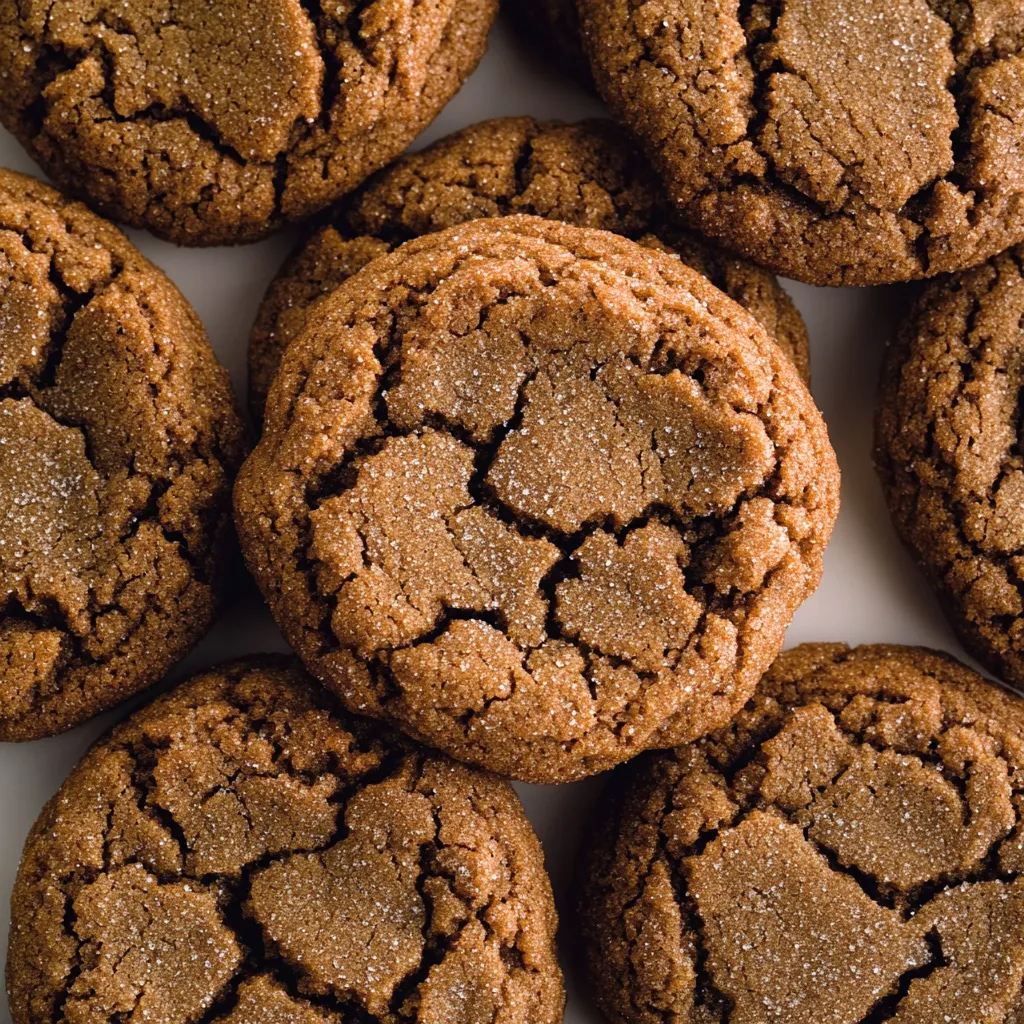 Pin it
Pin it
Creaming softened coconut oil with brown and white sugars then mixing in blackstrap molasses creates rich, dark cookie dough packed with warm spices like ginger, cinnamon, and cardamom. Rolling the dough balls in coarse natural cane sugar before baking creates sweet, crispy crusts that give way to fudgy, chewy centers. These don't require chilling and bake in just 10 minutes, making them perfect for busy holiday baking schedules. The molasses and spices create that classic gingerbread flavor but with better texture than traditional gingerbread cookies.
Molasses cookies became my cold-weather staple after discovering that blackstrap molasses creates much richer, more complex flavor than regular molasses. The first time I made these, I was skeptical about using coconut oil instead of butter, but the texture turned out perfect - crispy edges with chewy, almost fudgy centers. Learning that letting them cool on the baking sheet for 10 minutes is crucial explained why my first batch was too soft - moving them immediately didn't give them time to set up properly. Now I make these constantly throughout winter because they taste like holidays in cookie form.
Ingredients and Why They Matter
- Blackstrap molasses (½ cup): Rich, intense flavor; unsulphured preferred; regular molasses is milder
- Dark brown sugar (½ cup, packed): Moisture and molasses flavor
- Granulated white sugar (¼ cup plus more for rolling): Balances brown sugar
- Coconut oil (½ cup, softened but not melted): Creates texture; room temperature butter substitutes
- All-purpose flour (2 cups): Structure; measure by spooning and leveling
- Baking soda (2 teaspoons): Reacts with acidic molasses for rise
- Ground ginger (2 teaspoons): Main spice providing warm bite
- Ground cinnamon (1 teaspoon): Classic warm sweetness
- Ground cardamom (½ teaspoon): Aromatic complexity; ground cloves substitute
- Vanilla extract (1 teaspoon): Deepens spiced flavors
- Fine sea salt (½ teaspoon): Enhances all flavors
- Water (1-2 tablespoons): Moistens dough
- Natural cane sugar (½ cup, for rolling): Creates crispy crust; coarser than regular sugar
How To Make It
- Prepare and preheat:
- Line two large baking sheets with parchment paper and set aside. Preheat your oven to 350°F. Place about ½ cup natural cane sugar in a small, shallow bowl for rolling the cookies later. If your coconut oil is solid, microwave it for about 15 seconds until softened but not melted - it should be scoopable and spreadable but still hold its shape. The exact timing depends on your kitchen temperature.
- Cream coconut oil and sugars:
- In the bowl of a stand mixer fitted with the paddle attachment (or a large bowl using a hand mixer), beat the softened coconut oil, dark brown sugar, and granulated white sugar together on medium speed for 2-3 minutes until light and fluffy. Stop and scrape down the sides of the bowl as needed. The mixture should look paler and increased in volume from air being incorporated. This creaming process is important for creating the right texture.
- Add molasses and vanilla:
- Pour in the blackstrap molasses and vanilla extract. Beat on medium speed for about 1 minute until completely combined. The mixture will look very dark brown and uniform with no streaks remaining. The molasses should be fully incorporated throughout. Scrape down the bowl to ensure everything is mixed evenly.
- Mix dry ingredients:
- In a separate medium bowl, whisk together the all-purpose flour, baking soda, ground ginger, ground cinnamon, ground cardamom (or cloves), and salt. Whisk for about 30 seconds to ensure all the spices and leavening are evenly distributed with no clumps. Breaking up any brown sugar lumps with your fingers before adding helps prevent lumps in the dough.
- Combine wet and dry:
- With the mixer on low speed, gradually add the dry ingredients to the molasses mixture in three additions, mixing after each addition just until the flour begins to disappear. Don't overmix or the cookies will be tough - mix just until no large dry streaks remain. The dough will look thick and slightly crumbly. Add 1 tablespoon of water and mix briefly until the dough comes together and looks moistened. If the dough still seems very dry and crumbly, add another teaspoon of water and mix again. The dough should hold together when pressed but not be wet or sticky.
- Shape and coat cookies:
- Use a 2-inch cookie scoop (about 2 tablespoons) to portion the dough. Roll each portion between your palms to create smooth balls. Drop each dough ball into the bowl of natural cane sugar and roll it around until completely coated on all sides. The sugar should cover the entire surface - this creates the crispy crust. Place the sugar-coated balls on the prepared baking sheets, spacing them about 3 inches apart. They spread during baking, so don't crowd them. You'll likely need to bake in two batches.
- Flatten and bake:
- Before baking, use your palm or the bottom of a glass to gently press down on each dough ball, flattening it slightly - about ½ inch thick. They shouldn't be completely flat, just pressed down a bit. This helps them bake more evenly and spread properly. Bake one sheet at a time on the center oven rack for 10 minutes. The cookies are done when they've spread slightly, the edges look set, and characteristic cracks form on the surface. They'll still look slightly puffy and soft in the centers - that's correct. Don't overbake or they'll be hard rather than chewy.
- Cool properly:
- This step is crucial. Remove the baking sheet from the oven and let the cookies cool on the sheet for exactly 10 minutes without moving them. During this time, the cookies will deflate slightly and set up properly, developing their signature chewy texture. They'll feel delicate and soft straight from the oven but will firm up as they cool. After 10 minutes, use a thin spatula to transfer the cookies to a wire rack to cool completely. Repeat the baking and cooling process with the remaining dough. Store cooled cookies in an airtight container at room temperature for up to 4 days, or freeze for up to 3 months.
 Pin it
Pin it
Blackstrap molasses versus other molasses types confused me until tasting them side-by-side. Regular or mild molasses is the first extraction from sugar refining - it's light, sweet, and mild. Robust or full-flavored molasses is the second extraction with darker color and stronger flavor. Blackstrap is the third and final extraction - very dark, thick, and intensely flavored with slight bitterness. Blackstrap creates the most complex, deeply flavored cookies. Find it near regular molasses in stores, often labeled "unsulphured blackstrap."
Coconut Oil vs Butter
Using coconut oil instead of butter makes these cookies naturally vegan while creating excellent texture. Softened coconut oil creams with sugar similarly to butter, incorporating air for light texture. The coconut flavor is imperceptible in the finished cookies - the molasses and spices completely dominate. Room temperature butter substitutes perfectly if you're not keeping the recipe vegan. Either way, the fat should be soft enough to cream but not melted, which would create different texture.
The Creaming Method
Creaming fat and sugar together incorporates air that creates lighter texture and helps cookies spread properly. The sugar crystals cut into the fat, creating tiny air pockets. This takes 2-3 minutes with an electric mixer. The mixture should look paler and fluffy when properly creamed. Undermixing creates dense cookies. This step is foundational for proper cookie texture, so don't rush it. The incorporated air expands during baking, contributing to texture.
Natural Cane Sugar Coating
Natural cane sugar (also called turbinado or demerara) has larger crystals than regular granulated sugar. These coarser crystals don't dissolve as quickly during baking, creating distinct crispy, sparkly crust around the cookies. Regular granulated sugar works but creates less pronounced texture. The sugar coating also adds sweetness that balances the slight bitterness of blackstrap molasses. Rolling thoroughly ensures complete coverage for uniform crispness.
Spice Combinations
The trio of ginger, cinnamon, and cardamom creates complex warmth. Ginger provides spicy bite. Cinnamon adds familiar sweetness. Cardamom contributes floral, aromatic depth that makes these taste sophisticated. If cardamom is unfamiliar or unavailable, ground cloves substitute - use ¼ teaspoon as cloves are very strong. The spices should be fresh for best flavor - old spices taste flat and dusty. These warm spices define the cookies' holiday character.
Why Cookies Need Cooling Time
Straight from the oven, cookies are puffy and very soft because the structure hasn't fully set. The heat has expanded the dough and the fats are melted. During the 10-minute cooling period on the hot baking sheet, several things happen: the cookies deflate slightly, the fats solidify creating structure, and moisture redistributes. Moving them too early causes them to break or lose shape. The residual heat from the pan continues cooking them gently during this time.
Baking One Sheet at a Time
Ovens have hot spots and temperature variations between racks. Baking everything on the same center rack ensures even cooking. Cookies on lower racks may burn on the bottom before tops cook through. Upper racks may brown tops too fast. While baking in batches takes longer, it produces consistent results. If you must use multiple racks, rotate positions halfway through baking. These cookies spread significantly, so spacing is crucial too.
Storage and Freezing
These cookies keep at room temperature in airtight containers for 4 days. They may soften slightly over time but remain delicious. For longer storage, freeze them in airtight containers or freezer bags for up to 3 months. Separate layers with parchment to prevent sticking. Thaw at room temperature for about an hour, or microwave frozen cookies for 10 seconds to warm them. The texture holds up beautifully after freezing, making these excellent make-ahead holiday cookies.
 Pin it
Pin it
These chewy molasses cookies represent the kind of holiday baking that creates tradition and memories. The combination of crispy sugary edges and fudgy centers with warming spices creates something that tastes like comfort and celebration. When you pull a batch from the oven and smell the ginger and cinnamon filling your kitchen, you know winter has truly arrived. Sometimes the best recipes are the ones that become annual traditions because they're reliable, delicious, and genuinely special, and these molasses cookies definitely accomplish that goal perfectly every single time you make them.
Frequently Asked Questions
- → Can I use regular molasses instead of blackstrap?
- Yes, you can use regular molasses. Blackstrap gives a deeper flavor, but regular molasses works fine and makes a slightly sweeter cookie.
- → How do I store these cookies?
- Keep them in an airtight container at room temperature for up to 5 days. They stay soft and chewy when stored properly.
- → Can I make the dough ahead of time?
- Absolutely. You can refrigerate the dough for up to 3 days or freeze it for up to 3 months. Just let it come to room temperature before rolling.
- → Why are my cookies spreading too much?
- Make sure your butter isn't melted and your dough isn't too warm. Chilling the dough for 30 minutes before baking can help them hold their shape better.
- → Can I make these cookies dairy-free?
- Yes, just use the coconut oil option instead of butter. Make sure it's soft but not melted for the right texture.
- → What makes these cookies crinkle on top?
- The sugar coating and the way they puff up while baking creates those classic cracks. Using the recommended molasses and sugar brands helps too.
- → Do I need cardamom or can I skip it?
- Cardamom adds a nice flavor, but you can leave it out if you don't have it. The cookies will still taste great with just the ginger and cinnamon.
